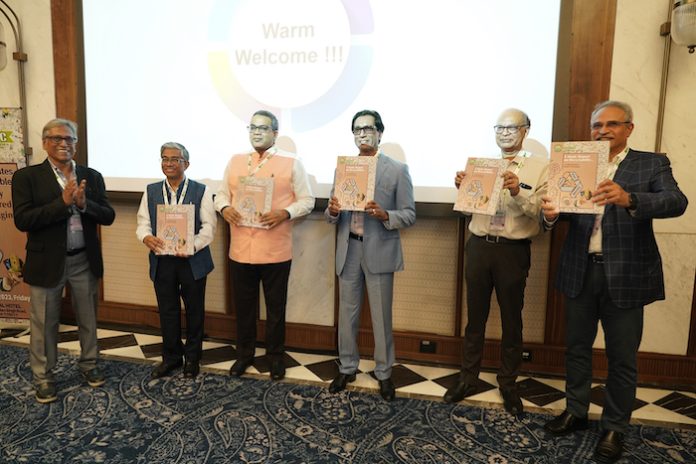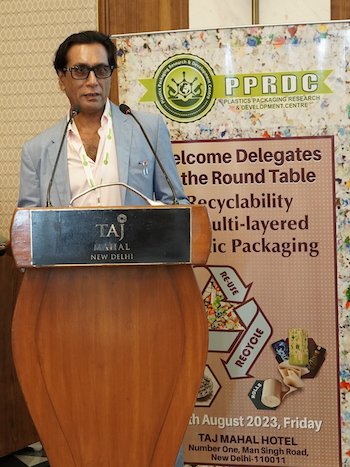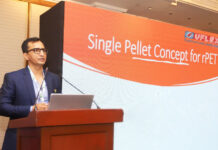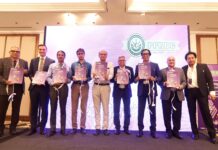
On 13 September 2023, the chairman and managing director of Noida headquartered UFlex Ashok Chaturvedi released a study report on the Recyclability of Multi-Layered Aseptic Packaging at a special roundtable organized by the Plastics Packaging Research and Development Centre (PPRDC) in New Delhi. The report was unveiled in the presence of Deepak Mishra, joint secretary, Department of Chemicals and Petrochemicals, Government of India, Professor (Dr) Shishir Sinha, DG-CIPET and brand owners and industry experts from across the country deliberating the future of recycling and the Indian government’s EPR guidelines.

Photo UFlex
On the occasion, Chaturvedi said, “We welcome the government’s initiatives toward clean India as it is a stepping-stone for a clean planet. As a global leader in packaging, we have made significant investments in industrial and multi-layer mixed plastic (MLP) waste recycling facilities across our global locations and very recently, in multi-layer aseptic recycling technology.”
“Historically, multi-layer aseptic packaging is considered ‘non-recyclable’ as the packaging structures are made of a mix of materials such as paper, polyethylene, and aluminium foil. Multi-layer aseptic packaging mostly ends up in landfills or is incinerated. UFlex has invested in an advanced Enzymatic Delamination Technology to enable aseptic packaging recycling. Enzymatic delamination utilizes enzymes to break down the bonding between different layers of the packaging materials, allowing for the separation of individual layers of the laminate such as paper, polyethylene and foil which can be reused in the production of new products. UFlex has set up a state-of-the-art aseptic packaging recycling facility in Gwalior and would like to invite brand owners, civic bodies, NGOs, and recyclers to visit our facilities and learn more about this technology.”
“This report will help brand owners and recyclers appreciate the technical processes, possibilities, and financial returns on recycling multi-layer aseptic plastic (MLAP) waste. In a country like India, this could provide a direction for the treatment of aseptic plastic waste in a sustainable manner and bring circularity in aseptic packaging.”
“While we have invested our own time and money, and developed technology to pave the way for recycling in India, we believe that adequate regulatory support in creating the right environment to boost recycling is the need of the hour. Often, a well-drafted law accelerates the pace of change like nothing else.”
The release of the report was followed by an address on ‘Aseptic Liquid Packaging – Opportunities and Challenges’ by Ashwini Sharma, president and CEO, Aseptic Liquid Packaging Business of UFlex. Sharma stated, “We recognize the critical role of aseptic packaging in our modern economy, and we are committed to driving innovation that aligns sustainability with economic progress. Our advanced enzymatic delamination technology is a testament to our investment and commitment to highly efficient, technologically advanced, and sustainable practices.”
Additionally, Sharma showcased UFlex’s advanced aseptic recycling facility at Gwalior which upcyles aseptic packaging waste into several industrial and daily-use items. A presentation on Recycling of MLP (Category III) – Recycling Methods by Jeevaraj Pillai, chief sustainability officer, UFlex and a Trustee of the PPRDC, and enzymologist Dr Paijit Sangchai followed. Vikas Garg from AA Garg and Company presented on Meeting the EPR guidelines for MLP (Category – III). Other speakers included Secretary General, and Coordinator, PPRDC, Mihir Banerjee and Manas Sarkar, Business HR head, and Sustainability Lead, Packaging Business, UFlex, and a Council Member of the PPRDC.
Based on a press release from UFlex and edited by Naresh Khanna










